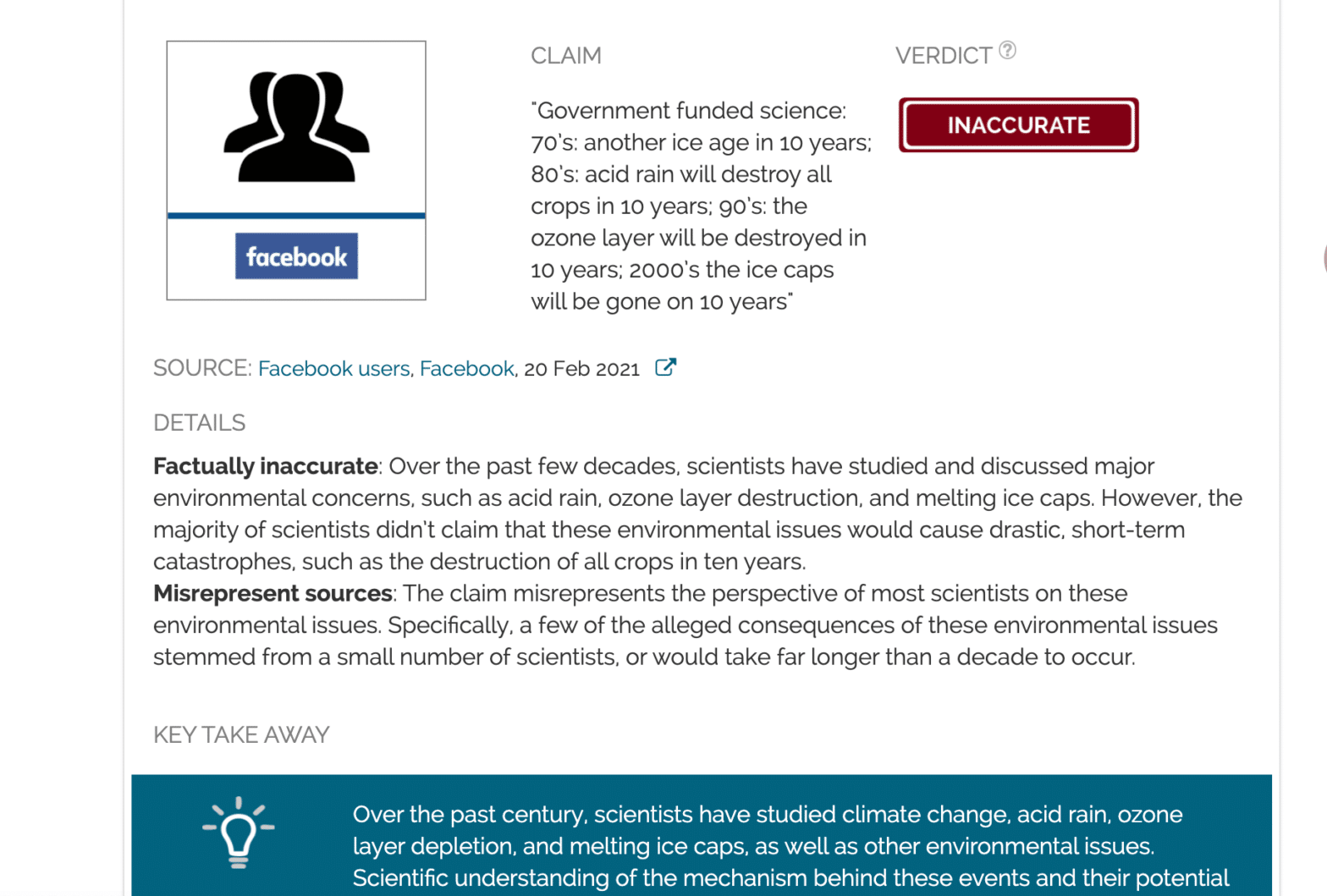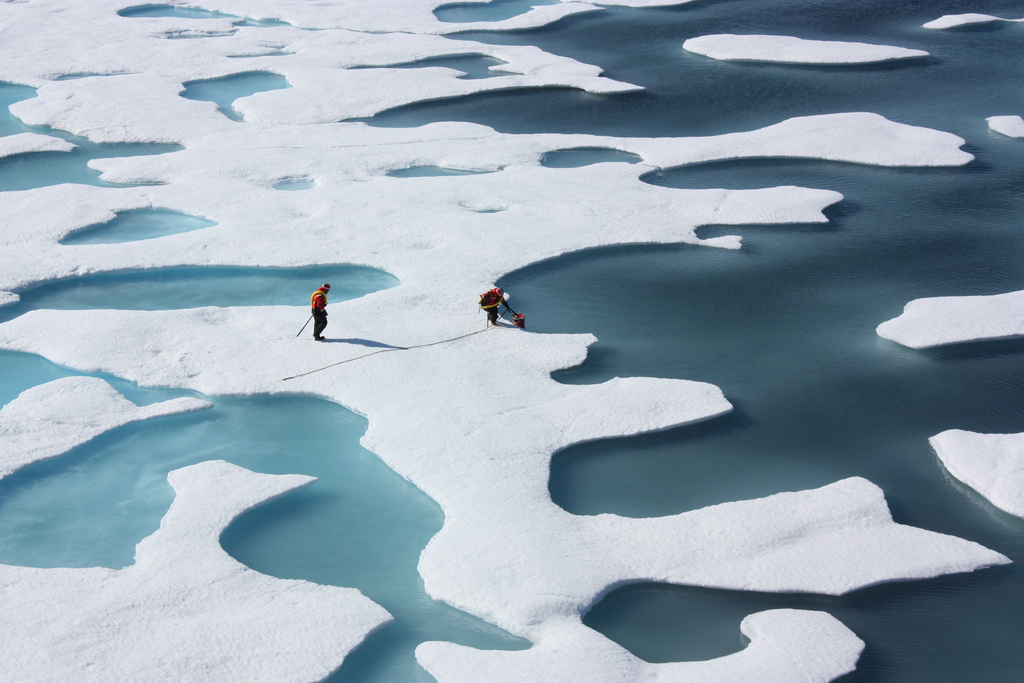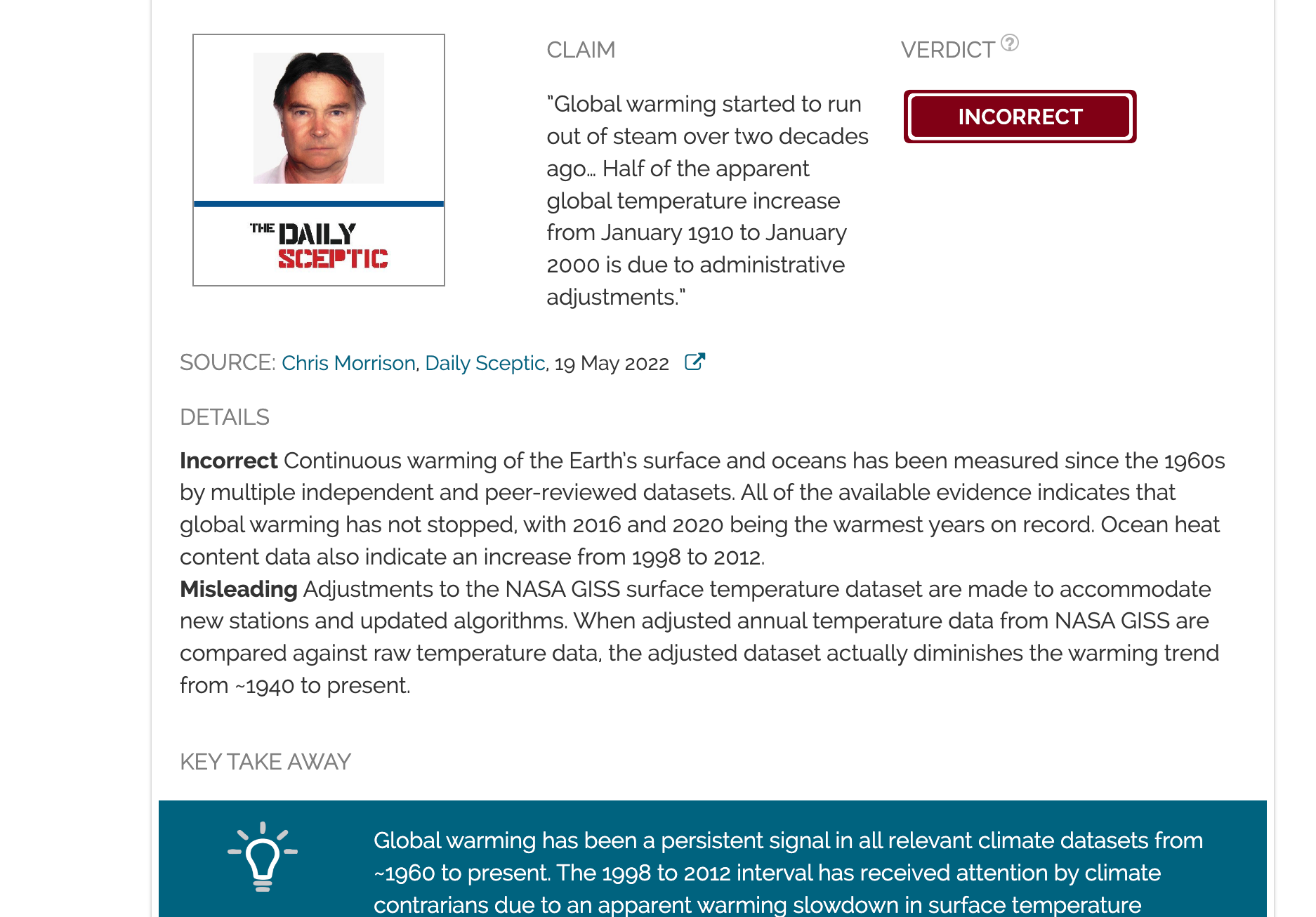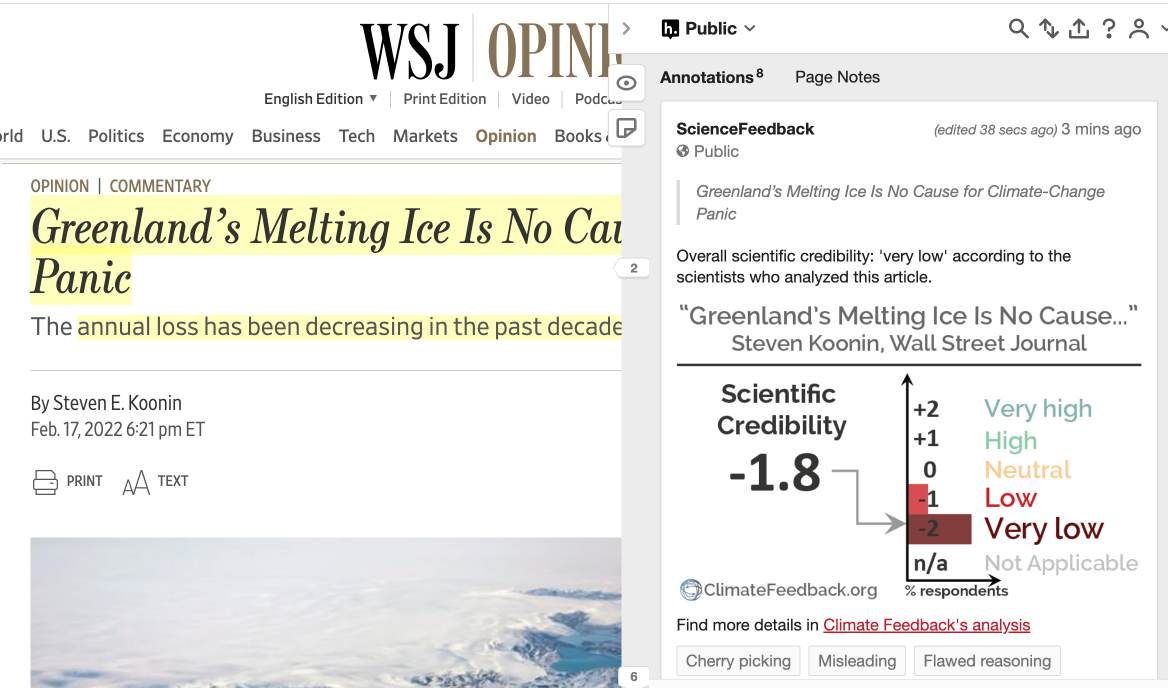- Climate
Scientists didn’t announce impending environmental catastrophes every decade since the 1970s
Key takeaway
Over the past century, scientists have studied climate change, acid rain, ozone layer depletion, and melting ice caps, as well as other environmental issues. Scientific understanding of the mechanism behind these events and their potential consequences has increased significantly through observational studies, experiments, and model simulations. Early warnings related to these environmental issues led to national and international regulations aimed at mitigating them, such as acid rain, ozone depletion, and climate warming.
Reviewed content

Verdict:
Claim:
Science said in the: 70s, another ice age in 10 years; 80s, acid rain will destroy all crops in 10 years; 90s: the ozone layer will be destroyed in 10 years; 2000’s the ice caps will be gone on 10 years
Verdict detail
Factually inaccurate:
Over the past few decades, scientists have studied and discussed major environmental concerns, such as acid rain, ozone layer destruction, and melting ice caps. However, the majority of scientists didn’t claim that these environmental issues would cause drastic, short-term catastrophes, such as the destruction of all crops in ten years.
Misrepresent sources:
The claim misrepresents the perspective of most scientists on these environmental issues. Specifically, a few of the alleged consequences of these environmental issues stemmed from a small number of scientists, or would take far longer than a decade to occur.
Full Claim
”Government funded science: 70’s: another ice age in 10 years; 80’s: acid rain will destroy all crops in 10 years; 90’s: the ozone layer will be destroyed in 10 years; 2000’s the ice caps will be gone on 10 years”
Review
The claim that government funded scientists have announced catastrophic short-term environmental effects every decade since the 1970s have been repeated in hundreds of Facebook posts such as this one.
In the 1970s, the majority of climate studies projected global warming
The claim that scientists announced a forthcoming ice age in the 1970s is a popular myth frequently used by those who want to cast doubt on what climate scientists say today about global warming. However, as stated in Peterson et al. (2008), “a review of the climate science literature from 1965 to 1979 shows this myth to be false. The myth’s basis lies in a selective reading of the texts both by members of the media at the time and by some observers today. In fact, emphasis on greenhouse warming dominated the scientific literature even then”.[1]
Only a few scientific studies predicted global cooling. For instance, in the often-cited Rasool and Schneider (1971) paper, the authors simulated the cooling effect of aerosols (suspended particles in the air) if their concentration were to increase significantly in the future[2]. However, it’s incorrect to claim there was a scientific consensus predicting global cooling and an imminent ice age. On the contrary, by the end of the 1970s scientists agreed that greenhouse gases were the dominant forcing of the global climate changes happening currently[1]. The few ice-age predictions were abandoned shortly thereafter. Furthermore, actions taken since the 1970s to reduce aerosol emissions resulting from industrial activity have strongly limited the cooling effect of aerosols on the climate.
Contrary to the claim’s suggestions, observed global warming patterns are well-aligned with most of the predictions made by scientists in the 1970s. In its 1979 report, the U.S. National Academy of Sciences concluded, “when it is assumed that the CO2 content of the atmosphere is doubled and statistical thermal equilibrium is achieved, the more realistic of the modeling efforts predict a global surface warming of between 2°C and 3.5°C, with greater increases at high latitudes”.[3] This is in close agreement with the latest estimation of Earth’s climate sensitivity, ranging 2.6-3.9°C[4].
In conclusion, the claim emphasizes a prediction from a minority of studies and neglects the scientific consensus that emerged in the 1970s on the role of greenhouse gasses as a major driver of global warming.
In the 1980s, scientists thought acid rain contributed to lake acidification and forest dieback
The claim that scientists projected the destruction of all crops within ten years due to acid rain is a misinterpretation of the scientific debate that occurred in the early 1980s. At the time, acid rain caused by nitrogen dioxide (NO2) and sulfur dioxide (SO2) emissions from coal power electricity plants and other sources was a major environmental concern. Scientists hypothesized that these emissions were responsible for lake acidification and the dying of forests in Europe and North America, resulting in numerous studies on the topic[5].
The U.S. National Acid Precipitation Assessment Program (NAPAP) was launched in 1980 to guide national debate on clean-air legislation. Researchers spent a decade studying atmospheric deposition and its effects on aquatic and terrestrial ecosystems. Irving (1990) explained, “when NAPAP was initiated in 1981, scientific opinion on acid rain was divided. The issue was viewed by some as a rapidly intensifying disaster requiring immediate remediation, and by others as a speculative hypothesis without sufficient substantiation. Most scientific opinion now lies well inside both of these two positions”[6]. The first NAPAP report concluded that acid rain damaged certain lakes and streams in the eastern United States and Canada, and contributed to the decline of high-elevation red-spruce forests[7].
Contrary to the claim, scientists didn’t project that all crops would be destroyed by acid rain within ten years. In a paper published in 1983, Irving indicated that an “analysis of the current literature concludes that the effects of acidic precipitation on crops appear to be minimal and that when responses are observed, they may be positive or negative”[8]. A couple of years later, a report from the U.S. Department of Agriculture reached the same conclusion, “acid rain seems to be far less damaging to agriculture (if damaging at all) than the gaseous pollutants”[9].
Gaseous pollutants, such as SO2 and NO2, and acid rain originate from similar sources: man’s pollutant emissions into the atmosphere. Adoption of policies like the Clean Air Act in the U.S., and the Geneva Convention on Long-Range Transboundary Air Pollution in Europe led to a drastic reduction of industrial SO2 and NO2 emissions, mitigating the effects of acid rain. For example, average annual ambient concentrations of SO2 decreased 93% between 1980 and 2018 in the U.S.[10].
In conclusion, the claim is misleading and doesn’t reflect the research and scientific discussions about acid rain that occurred in the 1980s.
In the 1990s, the ozone layer over the Antarctic was thinning dramatically in spring
The claim that scientists said the ozone layer would be destroyed in ten years is an exaggeration related to the discovery of the ozone hole. In the early 1980s, ground-based and satellite measurements revealed that the stratospheric ozone layer was thinning over the South Pole every spring. The reduction in ozone concentration was coined “ozone hole” metaphorically. The hole refers to the area in which ozone concentrations drop below the historical threshold of 220 Dobson Units. This observation raised concerns because stratospheric ozone protects Earth’s surface from the Sun’s harmful ultraviolet radiation.
From 1980 through the early 1990s, the ozone hole rapidly grew in area and depth, with ozone depletion of up to 60%. Contrary to the claim, the ozone hole is essentially a seasonal, regional-scale phenomenon in the Antarctic, although anomalous ozone decreases of about 4 – 5% per decade were also observed in the midlatitudes of both hemispheres[11]. In 1990, a simulation study showed that “as the vortex breaks down and the ozone hole is dispersed, significant depletions to column ozone, of order 10 Dobson units (3%) occur as far north as 40°S during austral summer”[12] . This study also concluded that 70% of the initially prescribed ozone deficit is replenished through stratospheric chemistry by the end of the year. A global and abrupt destruction of the ozone layer was, however, not projected in ten years.
During the 1980s, scientists discovered that human-made chemicals, such as chlorofluorocarbons (CFCs, used in refrigerators and aerosol spray), facilitated the destruction of the ozone layer. The global recognition of the destructive potential of CFCs led to the 1987 Montreal Protocol, a treaty that phased out the production of ozone-depleting chemicals. As a result, annual ozone holes roughly stabilized in the early 21st century.
A lack of action would have led to severe ozone depletion, with increased levels of solar UV radiation levels at the Earth’s surface. Prather et al. (1996) modeled the ozone response to continued growth of the ozone-depleting substances without the Montreal Protocol, and calculated a globally-averaged total ozone depletion of 10% by 1999[13]. A more complex simulation estimates that in the absence of regulation, 17% of the globally-averaged column ozone would have been destroyed by 2020, and 67% by 2065, in comparison to 1980[14]. Also, “large ozone depletions in the polar region become year round rather than just seasonal as is currently observed in the Antarctic ozone hole”. When taking into account the impact of the Montreal Protocol, the authors predicted that the ozone layer would recover by 2050-2060[14].
In conclusion, the claim is incorrect based on observations of the ozone hole and the projections made about ozone depletion in the 1990s.
In the 2000s, studies projected that polar ice caps could melt over millennia
The claim that scientists projected the imminent melting of ice caps is an overstatement that does not reflect current research or scientific understanding. The fate of the Arctic and Antarctic ice sheets is the subject of numerous observational studies and simulation research because of their contributions to sea-level rise. Unlike ice caps, sea ice does not raise sea-level when it melts, but has declined dramatically in the Arctic. In addition, the poles are warming at a rate nearly three times faster than the global average.
Due to different geographical settings, the Arctic and Antarctic ice sheets respond differently to the rise in global temperatures. In 2001, the Intergovernmental Panel on Climate Change (IPCC) third assessment report concluded, “The Antarctic ice sheet as a whole is likely to increase in mass during the 21st century. However, the West Antarctic ice sheet could lose mass over the next 1,000 years with an associated sea-level rise of several meters”[15].
In contrast, the report stated, the Greenland ice sheet is likely to lose mass during the 21st century and contribute a few centimeters to sea-level rise. Scientists projected more significant losses in ice sheet mass over millennial time scales, as the ice sheets continue reacting in response to climate warming. As stated in the IPCC report, “Ice sheet models project that a local warming of larger than 3°C, if sustained for millennia, would lead to virtually a complete melting of the Greenland ice sheet with a resulting sea-level rise of about 7 meters”.
Authors of the IPCC report acknowledged an incomplete understanding of some of the underlying processes. Based on more recent observations, the 2007 IPCC report concluded that the risk of additional contributions to sea-level rise from both the Greenland and possibly Antarctic ice sheets “may be larger than projected by ice sheet models and could occur on century time scales”[16]. At the time, polar ice sheets were shown to be losing mass at an accelerating rate by the end of the 2000s[17].
In conclusion, the claim is incorrect, as the possibility of an abrupt melting of ice caps wasn’t considered in the 2000s.
REFERENCES
- 1 – Peterson et al. (2012). The myth of the 1970s global cooling scientific consensus. Bulletin of the American Meteorology Society.
- 2 – Rasool and Schneider (1971). Atmospheric Carbon Dioxide and Aerosols: Effects of Large Increases on Global Climate. Science.
- 3 – Charney et al. (1979). Carbon dioxide and climate : a scientific assessment. National Academy of Science.
- 4 – Sherwood et al. (2020). An Assessment of Earth’s Climate Sensitivity Using Multiple Lines of Evidence. Reviews of Geophysics.
- 5 – O’Neill (1988) Acid Rain: A Selective Bibliography. California Polytechnic State University.
- 6 – Irving (1990) NAPAP Acid Rain Conference improves scientific consensus, discounts extremes. EOS.
- 7 – National Acid Precipitation Assessment Program (1991) Acidic deposition: state of science an technology.
- 8 – Irving (1983) Acidic Precipitation Effects on Crops: A Review and Analysis of Research. Journal of environmental quality.
- 9 – Barse et al. (1985) Effect of air pollution and acid rain on agriculture: an annotated bibliography. United State Department of Agriculture.
- 10 – United State Environmental Protection Agency (2020) The Legacy of EPA’s Acid Rain Research.
- 11 – WMO/UNEP (1994) Scientific Assessment of Ozone Depletion.
- 12 – Prather et al. (1990) Global impact of the Antarctic ozone hole: Dynamical dilution with a three‐dimensional chemical transport model. Journal of Geophysical Research – Atmospheres.
- 13 – Prather et al. (1996) The ozone layer: The road not taken. Nature.
- 14 – Newman et al. (2009). What would have happened to the ozone layer if chlorofluorocarbons (CFCs) had not been regulated? Atmospheric Chemistry and Physics.
- 15 – IPCC (2001) Climate Change 2001: Synthesis Report.
- 16 – IPCC (2007) Climate Change 2007: Synthesis Report.
- 17 – Velicogna (2009) Increasing rates of ice mass loss from the Greenland and Antarctic ice sheets revealed by GRACE. Geophysical Research Letters – The Cryosphere.



